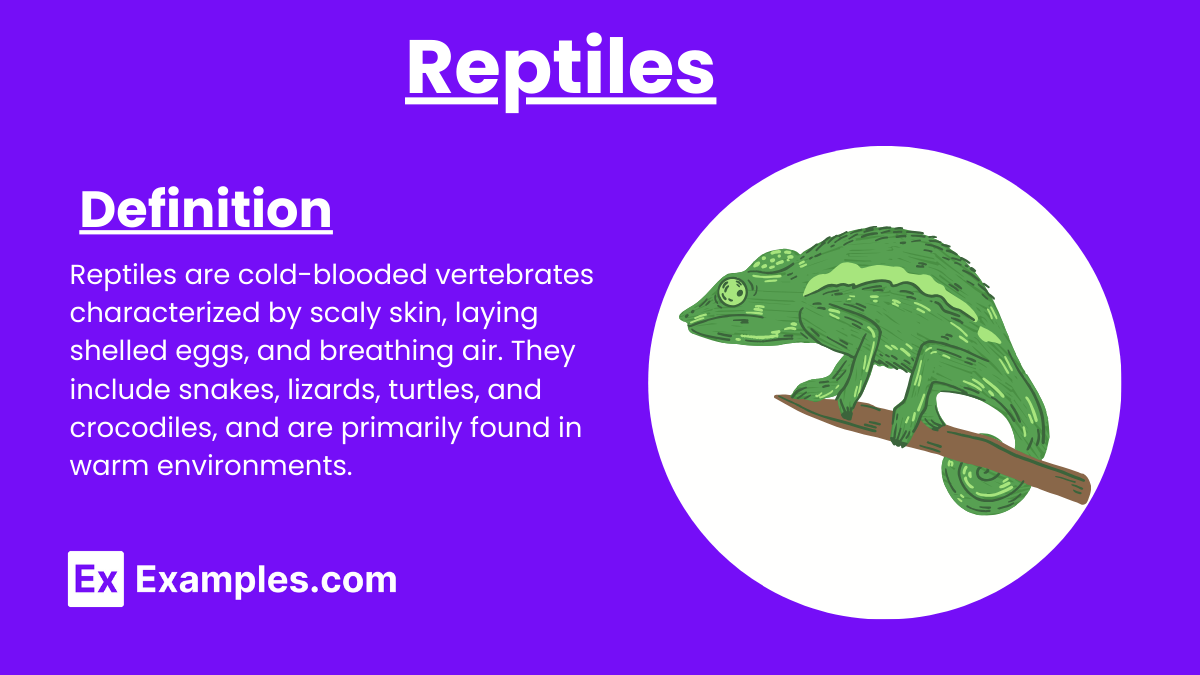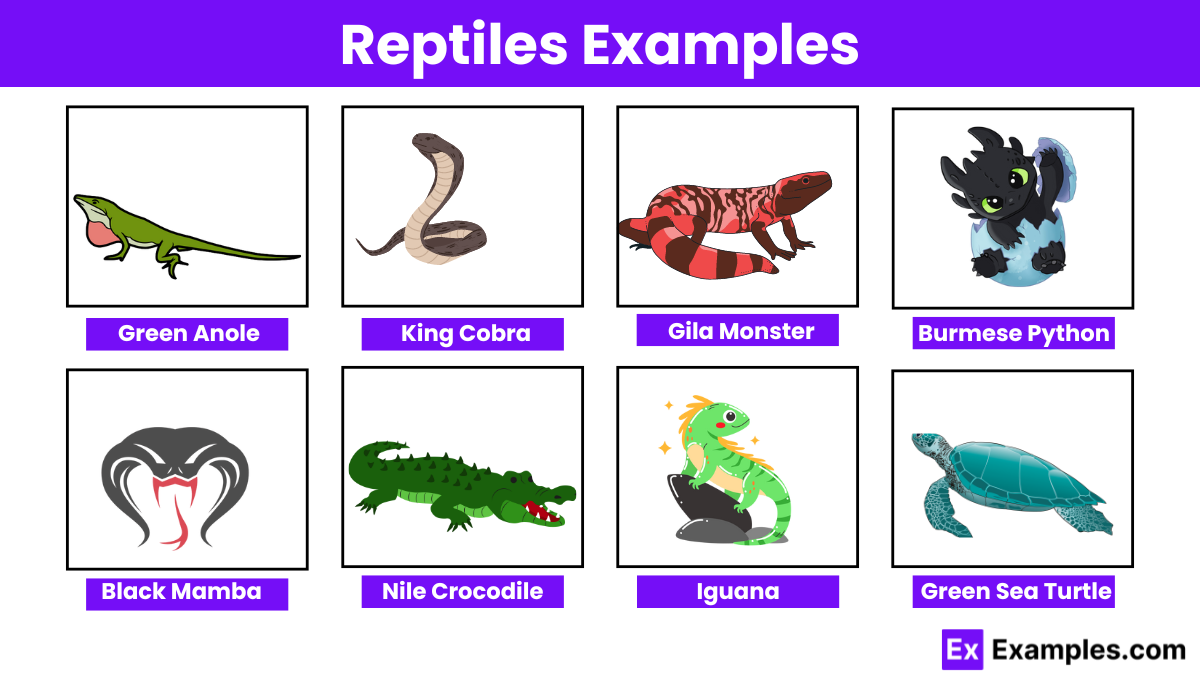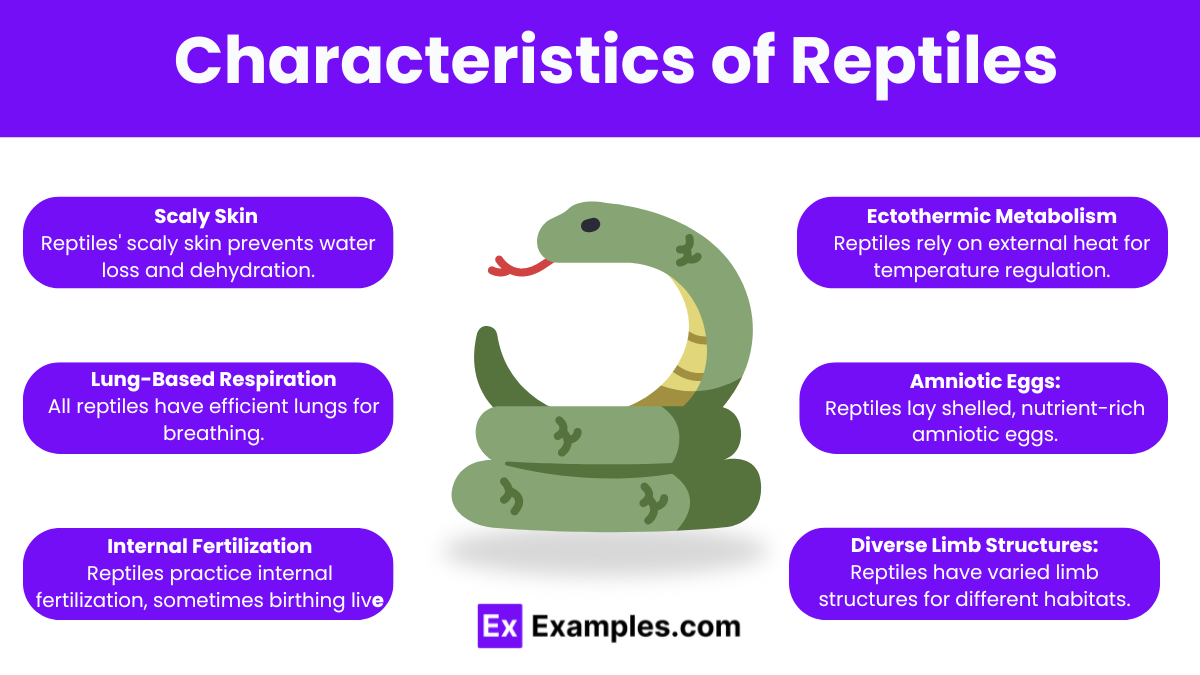Which of the following characteristics is typical of reptiles?
Warm-blooded metabolism
Moist skin for respiration
Scaly skin
Feathers for insulation


Reptiles are fascinating creatures that belong to the class Reptilia, which includes snakes, lizards, turtles, and crocodiles. These cold-blooded animals, also known as ectotherms, rely on external sources of heat to regulate their body temperature. Found in a variety of habitats, from deserts to rainforests, reptiles have adapted to survive in diverse environments. With their scaly skin, reptiles play crucial roles in ecosystems, often serving as both predators and prey in their natural habitats.
Reptiles are a class of animals that include snakes, lizards, turtles, and crocodiles. They have scaly skin, lay eggs, and breathe air through lungs. Reptiles inhabit various environments, from deserts to forests, and play essential roles in maintaining ecological balance.


Reptiles have dry, scaly skin that helps prevent water loss. These scales are made of keratin, the same protein found in human nails and hair. The scales provide protection and minimize dehydration, making reptiles well-suited to terrestrial environments.
Reptiles are ectothermic, meaning they rely on external heat sources to regulate their body temperature. Unlike endothermic animals, reptiles do not generate their own heat. They bask in the sun to warm up and seek shade or burrows to cool down.
All reptiles breathe through lungs, even those that live in water. Their lungs are more efficient than those of amphibians, allowing for better oxygen exchange. Some reptiles, like snakes, have a single functional lung that meets their respiratory needs.
Reptiles lay amniotic eggs, which have a protective shell and several membranes that provide nutrients and remove waste. This adaptation allows them to reproduce away from water bodies, unlike amphibians that require moist environments for their eggs.
Reptiles practice internal fertilization, where the male deposits sperm inside the female’s body. This method increases the likelihood of successful fertilization and embryo development. Some reptiles, such as certain species of snakes and lizards, give birth to live young.
Reptiles exhibit a wide range of limb structures adapted to their habitats. Most have four legs with clawed toes, but some, like snakes, have evolved to be limbless. Turtles have modified limbs for swimming, while lizards have limbs suited for climbing or running.
Reptiles exhibit a vast size range, from the tiny 1.6 cm dwarf gecko to the massive 7-meter-long saltwater crocodile. This diversity allows reptiles to occupy various niches within their ecosystem, contributing to ecological balance and biodiversity. Their size variations enable them to adapt to different habitats and play unique roles in their environments.
Reptiles are vertebrates characterized by scaly skin, ectothermic metabolism, and laying eggs or giving live birth. They include snakes, lizards, turtles, and crocodiles. Reptiles are crucial in ecosystems, often controlling pest populations. Unlike some species that exhibit parasitism, reptiles typically don’t rely on other organisms for survival but play essential roles in maintaining ecological balance.
Reptiles exhibit varying growth rates, shedding their skin periodically as they develop. Growth continues throughout their lives, though it slows with age. Longevity varies significantly among species: some lizards live only a few years, while tortoises can exceed a century. Factors such as habitat, diet, and predation influence their growth and lifespan.
They rely on external sources like sunlight to warm up or cool down.
They range from carnivorous to herbivorous, depending on the species.
Most reptiles have lungs, but some aquatic species can also breathe through their skin.
No, only some reptiles, like certain snakes and lizards, have venom glands.
Most reptiles reproduce by laying eggs, but some give birth to live young.
Reptile skin is covered in scales or scutes that provide protection and reduce water loss.
They use a variety of methods including crawling, slithering, and swimming.
Reptiles inhabit diverse habitats including deserts, forests, grasslands, and aquatic environments.
Lifespan varies greatly by species, from a few years to several decades or more.
Most reptiles are solitary, though some exhibit social behaviors, especially during mating or basking.
Text prompt
Add Tone
10 Examples of Public speaking
20 Examples of Gas lighting
Which of the following characteristics is typical of reptiles?
Warm-blooded metabolism
Moist skin for respiration
Scaly skin
Feathers for insulation
Which group of reptiles is known for laying eggs with hard shells?
Amphibians
Lizards
Turtles
Snakes
What is the primary function of the reptilian heart?
To circulate oxygen-rich blood only
To maintain body temperature
To separate oxygenated and deoxygenated blood
To assist in digestion
Which reptile is known for its ability to change color for camouflage?
Crocodile
Chameleon
Iguana
Gecko
What adaptation allows reptiles to thrive in dry environments?
Ability to breathe underwa
Cold-blooded metabolism
Scales to reduce water loss
Lungs for respiration
Which of the following is NOT a characteristic of reptiles?
Ectothermic (cold-blooded)
Lungs for breathing
Fur for insulation
Internal fertilization
What is the main difference between alligators and crocodiles?
Their skin texture
Their habitat preferences
The shape of their snouts
Their reproductive methods
Which type of reptile is primarily known for its ability to glide?
Green iguana
Flying dragon
Komodo dragon
Sea turtle
What do most reptiles use to regulate their body temperature?
Behavioral adaptations
High metabolic rates
Internal fat stores
Large body size
Which reptile is considered a living fossil, having changed very little over millions of years?
Monitor lizard
Leatherback turtle
Tuatar
Alligator
Before you leave, take our quick quiz to enhance your learning!

